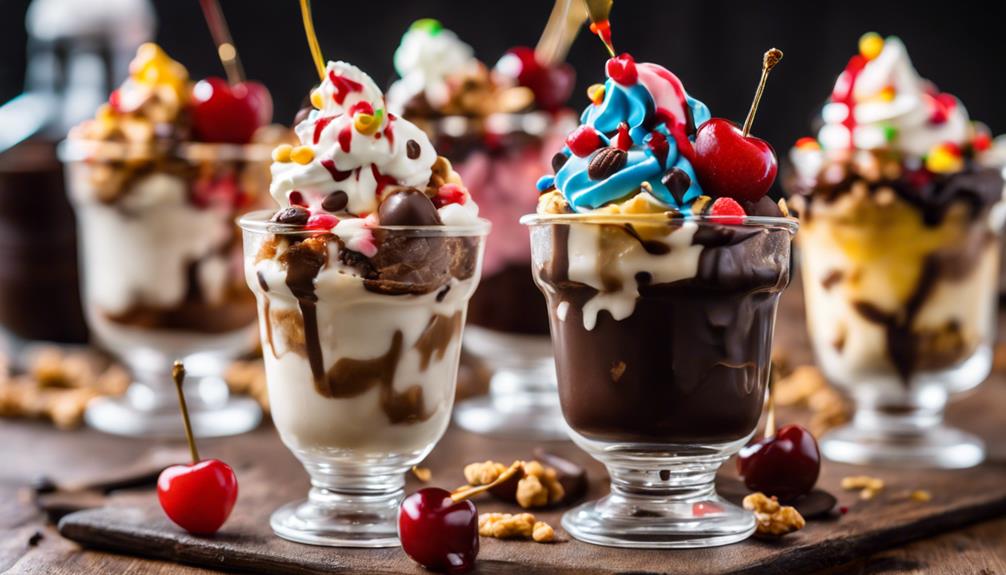Frozen yogurt is a delicious dessert made from yogurt and dairy, providing a healthier alternative to traditional ice cream. It typically contains live cultures, making it probiotic and beneficial for digestion. In comparison to ice cream, frozen yogurt generally has lower fat and higher protein levels, appealing to those who are health-conscious. It is available in various forms, such as soft serve or hard pack, and comes in a wide range of flavors from traditional vanilla to trendy matcha. Additionally, customizable toppings enhance its appeal. To learn more about its production, nutritional benefits, and market trends, continue exploring!
Key Takeaways
- Frozen yogurt is a lower-fat dessert made from yogurt, dairy products, sweeteners, and live bacterial cultures, requiring at least 10 million cultures per gram to be probiotic.
- It originated in the 1970s as a healthier alternative to ice cream, gaining popularity through customizable options and self-service formats.
- The production process involves pasteurizing milk, fermenting with live cultures, adding sweeteners, and churning to prevent large ice crystals for a smooth texture.
- Nutritionally, frozen yogurt often has lower fat and higher protein than ice cream, but may contain more sugar; awareness of ingredients is essential.
Definition of Frozen Yogurt
Frozen yogurt is a delicious dessert made from yogurt and dairy products, often sweetened and available in a variety of flavors. Unlike traditional ice cream, frozen yogurt is lower in fat, making it a popular choice for those seeking a healthier treat. The primary ingredients include cultured milk, such as whole, low-fat, or non-fat milk, which contributes to its creamy texture and distinctive flavor.
What sets frozen yogurt apart is the incorporation of live cultures during production. These live cultures ferment lactose into lactic acid, enhancing the flavor and thickening the product. To qualify as a probiotic, frozen yogurt must contain at least 10 million live cultures per gram, according to the National Yogurt Association. The tangy taste from these cultures is one of the key characteristics that many people enjoy.
Sweeteners like cane sugar or corn syrup are added to create a balanced flavor profile, while various flavorings—such as vanilla, chocolate, and fruit purees—make frozen yogurt even more enticing. Some varieties may also include stabilizers or thickeners for improved texture. Overall, frozen yogurt offers a delightful and health-conscious dessert option.
History of Frozen Yogurt

In the 1970s, a new dessert emerged in New England as a healthier alternative to traditional ice cream, sparking the evolution of frozen yogurt. Initially, the taste of frozen yogurt was too similar to regular yogurt, which hindered its marketing success. Manufacturers quickly realized they needed to refine their recipes to appeal to a broader audience.
As time passed, frozen yogurt's popularity surged, especially with the rise of brands like Pinkberry. They introduced customizable frozen yogurt options, allowing you to choose from a variety of flavors and toppings, creating a more engaging experience. This shift in how frozen yogurt was presented helped transform it into a trendy dessert choice.
The introduction of self-service frozen yogurt machines by 16 Handles further boosted the trend, giving you the freedom to mix flavors and control portion sizes. Today, frozen yogurt has diversified into countless flavors and styles, leading to the establishment of numerous frozen yogurt chains worldwide. It's not just a treat; it's a customizable experience that continues to captivate dessert lovers everywhere.
Key Ingredients
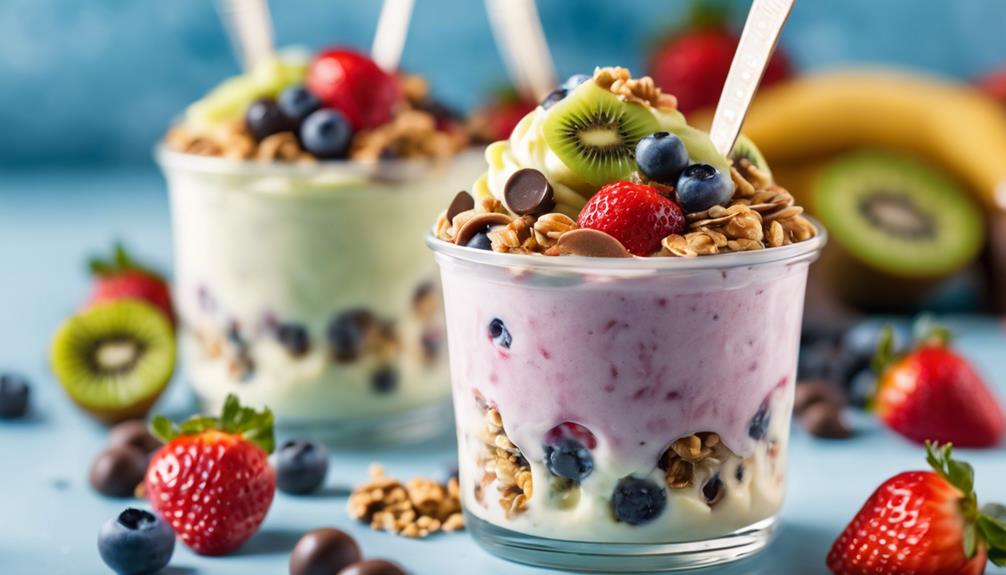
When you enjoy frozen yogurt, you're tasting a mix of vital ingredients that create its unique flavor and texture.
The primary components, along with various flavorings and sweeteners, play significant roles in making each scoop delightful.
Let's explore what goes into your favorite treat and how these ingredients come together.
Primary Components Overview
What makes up the delightful treat we enjoy as frozen yogurt? At its core, frozen yogurt is a blend of milk, live bacterial cultures, sweeteners, and a touch of fat.
You'll often find whole, low-fat, or non-fat milk as the primary base, which contributes to its creamy texture. The live bacterial cultures are vital, as they not only help in fermentation but also enhance the flavor profile, giving you that tangy taste you love.
Sweeteners like cane sugar or corn syrup are added to elevate the overall taste, and the level of sweetness can really change how you perceive each flavor. Fat content plays an important role too; it usually ranges from 0.55% to 6%, providing richness and creaminess that make frozen yogurt stand out from other desserts.
To guarantee a smooth experience, stabilizers and thickeners are often included to prevent large ice crystals from forming when frozen. This careful combination of ingredients creates the delightful texture and flavor that you savor in every scoop of frozen yogurt.
Flavoring and Sweetening Options
The delightful experience of frozen yogurt is largely enhanced by a variety of flavoring and sweetening options that cater to different tastes and preferences. When you visit frozen yogurt shops, you'll find an array of flavoring options like fruit purees, chocolate, vanilla, and even unique spices, which create diverse taste profiles. This variety not only adds excitement but also allows for customization to suit your palate.
Sweeteners play an essential role in defining the taste and texture of frozen yogurt. Common sweeteners like cane sugar or corn syrup contribute to a sweeter flavor and help maintain a smooth texture by preventing large ice crystals during freezing. This is one reason why frozen yogurt has become a popular alternative to ice cream; it offers a creamier, more enjoyable experience.
Additionally, many products incorporate stabilizers and thickeners, such as carrageenan or locust bean gum, to improve consistency. This guarantees that every bite you take is as delightful as the last. With so many flavoring and sweetening options available, you can easily find combinations that resonate with your personal taste.
Production Process

Frozen yogurt production kicks off with pasteurizing milk to eliminate harmful bacteria, setting the stage for a delicious treat.
After this vital step, you'll introduce live yogurt cultures, which ferment the mixture at 32°C for several hours. This fermentation is key to developing the yogurt's unique flavor.
Next, sweeteners and flavorings are added before the mixture undergoes initial freezing. This process incorporates air, creating a smooth consistency that makes frozen yogurt a favorite among dessert lovers. To guarantee that large ice crystals don't form, the mixture is churned while cooling.
Here's a quick overview of the production process:
- Pasteurization: Eliminates harmful bacteria
- Fermentation: Introduces live yogurt cultures for flavor
- Freezing: Incorporates air for smooth texture
Once the desired texture is achieved, the frozen yogurt is packed and cooled further, ready to be enjoyed.
Whether you prefer soft-serve or hard-pack options, the production of frozen yogurt focuses on maintaining quality and achieving that perfect creamy texture.
Nutritional Comparison
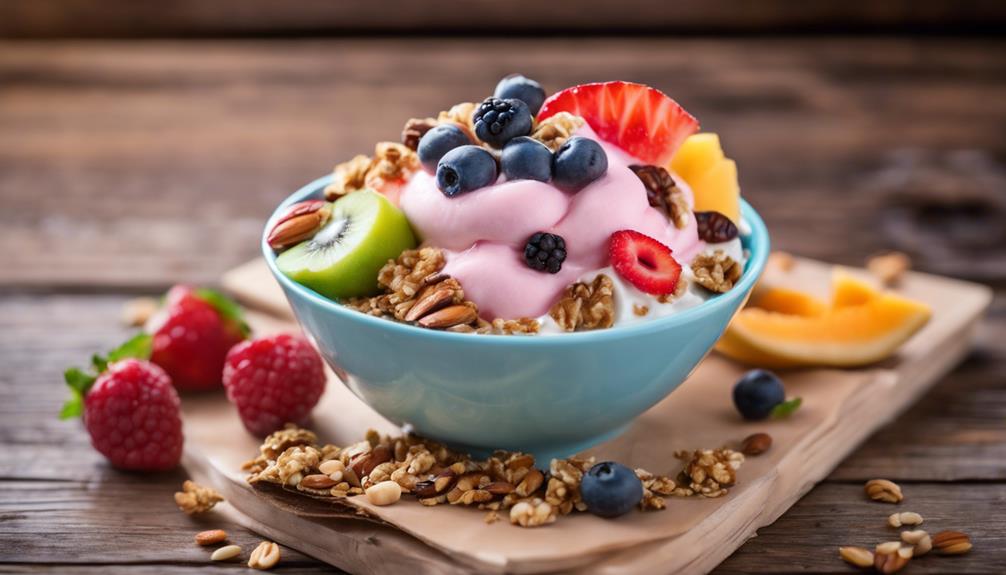
When comparing frozen yogurt to traditional ice cream, you'll find that it often offers a lower-fat option while packing in more protein. This makes frozen yogurt a popular choice for those looking for a healthier dessert. However, it's crucial to recognize that the nutritional values can vary based on the specific ingredients used.
Here's a quick comparison:
| Nutritional Aspect | Frozen Yogurt | Traditional Ice Cream |
|---|---|---|
| Fat Content | Lower | Higher |
| Protein Content | Higher | Lower |
| Sugar Content | Higher | Varies |
Frozen yogurt contains beneficial live cultures that can aid digestion, leading to additional health benefits. Despite its higher sugar content compared to ice cream, it remains a lower-fat alternative that many people enjoy.
As you explore different frozen yogurt options, pay attention to the ingredients listed. Some products may not require emulsifiers, which can simplify the ingredient list. Ultimately, understanding these nutritional values helps you make an informed choice about your dessert.
Types of Frozen Yogurt
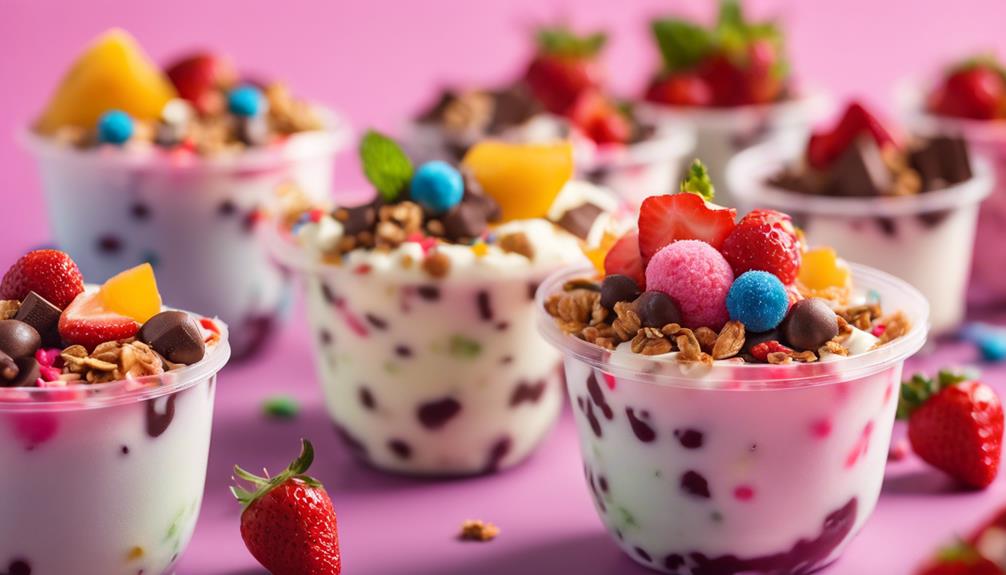
Understanding the nutritional differences sets the stage for exploring the various types of frozen yogurt available, each offering unique textures and flavors. In the dessert market, the two main types stand out: Soft Serve and Hard Pack.
Soft Serve: Creamier and served at warmer temperatures, this type is often found in frozen yogurt shops, allowing you to customize it with toppings.
Hard Pack: Firmer in texture, hard pack requires scooping, and you'll typically find it in grocery stores and ice cream parlors.
Dietary Variations: Options like low-fat, sugar-free, and non-dairy cater to diverse dietary needs.
Flavor Variety: Many shops rotate their flavors, so you can enjoy unique combinations and seasonal offerings.
With these options, you can choose the frozen yogurt that best fits your taste and dietary preferences.
Whether you're indulging in a creamy soft serve or a classic hard pack, there's something for everyone in the world of frozen yogurt!
Popular Flavors and Toppings
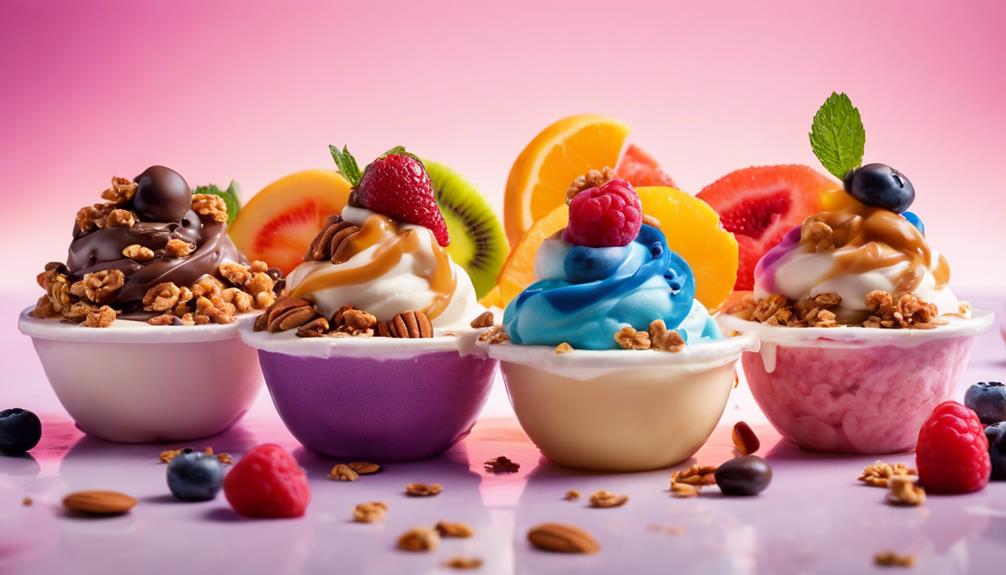
A delightful array of popular flavors and toppings makes frozen yogurt a favorite treat for many. You'll find classic options like vanilla, chocolate, and strawberry alongside unique varieties such as green tea, cookie dough, and seasonal delights like pumpkin and peppermint. Many shops keep things exciting with rotating flavors to encourage you to come back for more.
When it comes to toppings, the possibilities are endless! You can customize your frozen yogurt experience, selecting from fresh fruits, nuts, and granola to more indulgent choices like chocolate chips, candies, and syrups. This variety caters to everyone, including health-conscious individuals who prefer lighter toppings.
Here's a quick look at some popular frozen yogurt flavors and toppings:
| Popular Flavors | Indulgent Toppings | Health-Conscious Toppings |
|---|---|---|
| Vanilla | Chocolate Chips | Fresh Fruits |
| Green Tea | Candy Sprinkles | Nuts |
| Strawberry | Caramel Syrup | Granola |
With so many options available, it's easy to see why frozen yogurt is a customizable and delightful treat for anyone!
Health Benefits

Frozen yogurt offers several health benefits that make it a smart dessert choice for those seeking a delicious yet nutritious treat. You'll find that it often has a lower fat content than traditional ice cream, making it an excellent option for those looking to cut down on fat intake. Additionally, many frozen yogurt varieties are rich in protein, providing more per serving than standard ice cream.
Here are some key health benefits of frozen yogurt:
- Probiotic cultures: These live cultures can support digestion and improve gut health.
- Low-fat options: Many brands offer low-fat varieties, helping you indulge without excess calories.
- Protein source: Depending on the formulation, frozen yogurt can deliver a satisfying amount of protein.
Regularly enjoying frozen yogurt can contribute to enhanced immune function and overall health, especially when you choose varieties with live cultures.
Market Trends

The frozen yogurt market is booming, driven by consumers' growing health consciousness and their demand for low-fat and low-sugar options. As you explore this vibrant landscape, you'll notice some key trends shaping the industry.
| Trend | Description |
|---|---|
| Health Consciousness | Increased demand for healthier dessert options |
| Probiotic Offerings | Popularity of frozen yogurt with digestive benefits |
| Plant-Based Alternatives | Growth in vegan and dairy-free frozen yogurt |
| Flavor Innovations | Unique flavors driving impulse purchases |
| Regulatory Influence | Labeling affecting consumer choices |
These market trends reflect a shift in consumer preferences. You're likely to find probiotic frozen desserts that not only satisfy sweet cravings but also contribute to digestive health. In addition, the demand for plant-based options continues to rise, allowing you to indulge guilt-free. As frozen yogurt shops innovate with exciting flavors and shapes, your experience is enhanced, encouraging repeat visits.
Frequently Asked Questions
What Is the Science Behind Frozen Yogurt?
The science behind frozen yogurt involves fermenting milk with cultures, pasteurizing, and adding sweeteners. Churning while freezing prevents large ice crystals, ensuring a creamy texture while maintaining probiotic cultures for health benefits.
What Defines Frozen Yogurt?
You might think frozen yogurt's just another dessert, but it's defined by its live cultures and lower fat content. This tangy treat offers a delightful alternative to ice cream, making it both tasty and healthier.
What Makes Frozen Yogurt Different From Yogurt?
Frozen yogurt differs from regular yogurt in texture and sweetness. It's creamier and sweeter due to added sugar and dairy products, while regular yogurt is typically tangier and consumed in its liquid form.
What Is the Process of Frozen Yogurt?
You start by pasteurizing milk, then add live cultures for fermentation. Next, you mix in sweeteners and flavorings, churn while cooling, and finally serve it soft or hardened, ensuring a smooth texture throughout.
Conclusion
To sum up, frozen yogurt is a delicious treat that's come a long way since its invention.
Did you know that the frozen yogurt market is expected to reach over $3 billion by 2025? That's a reflection of how much you and others love it!
With its variety of flavors and healthier options, it's no wonder frozen yogurt remains a popular choice for dessert.
So next time you indulge, remember you're part of a growing trend!










